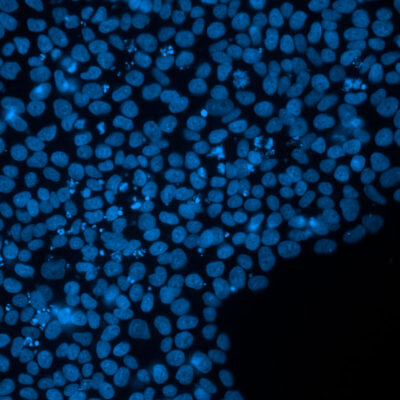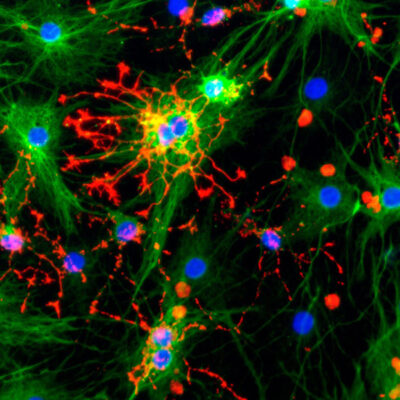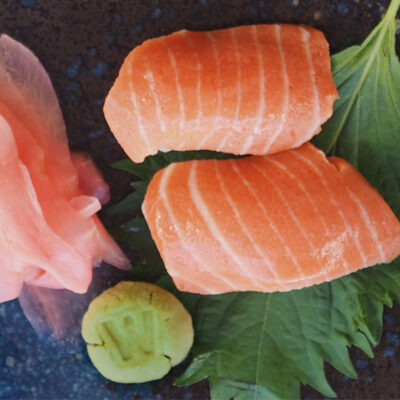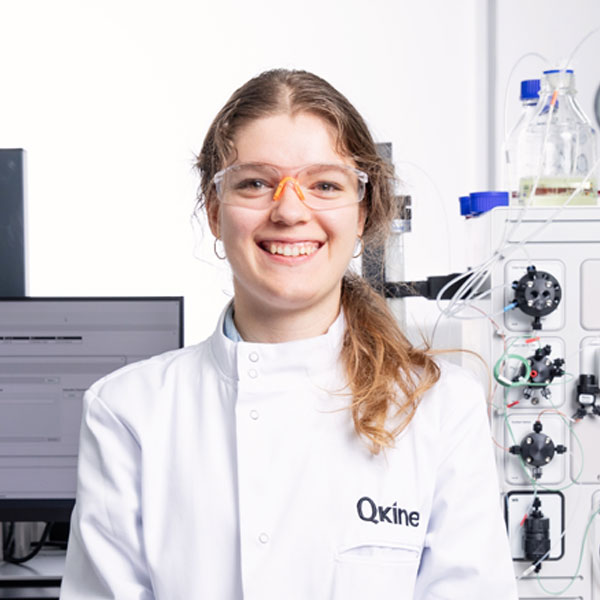Handling your Qkine proteins
Thank you for purchasing your protein from Qkine! We are committed to manufacturing enhanced-quality bioactive proteins to improve your scientific outcomes and reproducibility.
Providing you the highest-quality growth factors and cytokines

Storage and reconstitution instructions
Lyophilized (freeze-dried) proteins can be considerably more stable than proteins in solution during storage. This allows proteins to be shipped at room temperature – good for the environment and your experiments.
We thoroughly validate all storage and shipping of our proteins. In some cases, the intrinsic biochemical properties of the protein prevent effective lyophilization and reconstitution. In those circumstances, we store and ship proteins frozen in solution (on dry ice).
All proteins should be stored at -80 °C on receipt (or -20 °C if you don’t have access to -80 °C storage).
Reconstitution solution finder
How to store your proteins
How to reconstitute lyophilized protein
1 – Check the resuspension solution recommendation on the product datasheet or use the quick reconstitution solution finder above*.
2 – Centrifuge briefly before reconstituting to ensure all powder is at the bottom of the vial.
3 – Add sufficient reconstitution solution to give a protein concentration of 0.05–1.0 mg/ml.
4 – Allow the reconstituted sample to stand at room temperature for >1 minute before gently agitating, do not vortex and avoid foaming.
Reconstitution calculator
Use our reconstitution calculator to determine the necessary volume of a reagent for reconstituting your vial.
Enter the mass of your protein and the desired concentration of your final solution, then click solve.
Desired concentration (μg/ml)
5 – Prepare single-use aliquots whenever possible to avoid freeze-thaw cycles which can damage the proteins and reduce bioactivity. Store aliquots at -80 °C (or -20 °C)**.
NOTES
*Physiological buffers may cause precipitation of proteins during reconstitution. This is especially important for TGF beta family and other related growth factors so it is very important that these are reconstituted in Solution A (10 mM HCl, 1:1000 dilution of concentrated HCl).
**All our proteins are supplied carrier protein-free. If compatible with your work and you are storing at lower concentrations (<50 μg/ml) adding carrier protein is highly advised (usually 1% w/v high purity BSA or equivalent – ensure all buffers are sterile-filtered).
Featured scientific areas
FAQs
Qkine uses freeze drying to remove water and other solvents from our growth factors to ensure the preservation of activity, improve solubility, and enhance protein stability during shipping and storage. This is achieved by freezing the target proteins with selected excipients and cryoprotectants and allowing the frozen solvents to sublimate under vacuum.
Our freeze-dried growth factors will usually form a well-formed porous structure (the cake) which retains the physical size of the volume of liquid when frozen i.e. a 25 µg vial will contain a cake of roughly 25 µl. In some cases, our growth factors are formulated to be stable in the absence of bulking agents, such as mannitol, and tend to undergo a collapse of the porous structure of the cake during lyophilization. This results in a powdery/speckled appearance without affecting the stability or activity of the proteins.
The appearance of the lyophilized product depends on the exact excipients used and the resulting glass transition temperature, but we would routinely expect to see the following types of structures for our products:
- The product appears as a white powder speckled up to the height of the initial liquid. This is due to a lack of a bulking agent resulting in a cosmetic cake collapse during lyophilization.
Typical for products lyophilized from Tris, HEPES/NaCl, PBS, Tris/NaCl, HEPES/NaCl/CyS or Tris/NaCl/CyS
- The product appears as a visible cake of roughly equal volume to the initial volume of liquid. Due to the lack of a bulking agent some shrinkage may occur when air is reintroduced after lyophilization resulting in separation of the cake from the tube walls.
Typical for products lyophilized from acetonitrile/TFA
- The product appears as a well-formed visible cake of roughly equal volume to the initial volume of liquid.
Typical for products lyophilized from Tris/mannitol, Tris/NaCl/CyS/mannitol or acetonitrile/TFA/mannitol
- The product appears as a well-formed visible cake of roughly equal volume to the initial volume of liquid. Some puffing of the cake may be visible due to expansion of air bubbles during sublimation without affecting protein stability.
Typical for products lyophilized from HEPES/NaCl/mannitol
- The product may appear translucent
With Qkine’s continuous improvement strategy, our freeze-drying process has developed and evolved. It is normal for products dried under the previous lyophilization process to appear translucent.
Adding a carrier protein increases protein stability, extends shelf life, allows the protein to be stored at more dilute concentrations, and helps avoid the product sticking to the walls of the vial. Consequently, adding carrier proteins can be very helpful. However, most carrier proteins are animal-derived so for animal-free and sensitive applications and assays for which BSA might interfere with the assay, carrier-free proteins are the way to go. If compatible with your work, you can add your own carrier proteins, such as BSA, HSA or gelatin when you make aliquots. Adding your own carrier allows you to select an application-compatible carrier. We recommend always using a high-purity carrier protein.
Growth factor shelf life is influenced by many factors, including storage state, buffer ingredients, storage temperature and the stability of the protein itself. Generally speaking, growth factors are most stable when lyophilized. Our lyophilized proteins have been verified to be stable at room temperature for 3 days, or frozen for up to 2 years (either at -20 oC or -80 oC).
Once reconstituted, recombinant proteins can be stored at 4oC for 1-2 weeks, however we recommend freezing single use aliquots and defrosting fresh each time to ensure maximum protein stability and activity. Reconstituted proteins can be stored frozen for up to 1 year. When freezing reconstituted growth factors prepare single use aliquots. Every freeze-thaw cycle may cause some denaturation of the protein so repeated freeze-thaw cycles should be avoided. Always check the product sheet for freezing recommendations, but generally -20°C is suitable for short-term storage and -80°C for long term storage.
Lyophilized (freeze dried) proteins are considerably more stable than proteins in solution, consequently many proteins ship in lyophilized forms. This extends the time and temperature range at which the proteins can be shipped while maintaining the activity of the protein – good for the environment and your experiments. Lyophilized proteins are generally stable at room temperature for one month (we verify stability over a standard 3-day shipping cycle), or frozen at -20 oC or -80 oC for 2 years. However, on occasion lyophilization can cause partial loss of activity and damage protein structure, so some proteins are supplied in buffer.
We have compared our lyophilized proteins incubated at 37 °C for 3 days with those stored at -80 °C and found no difference in their bioactivity (EC50) using our standard assays. Therefore, as part of our commitment to the environment and supporting more eco-friendly packaging, we send all of our lyophilized proteins at room temperature, avoiding the need for dry ice, ice packs and gels.
Every effort is made to ensure samples are sterile; however, we recommend sterile filtering after dilution in media or the final working solution.
TGF beta family proteins and other growth factors can be very poorly soluble in physiological solutions. Please follow the handling guidance for lyophilized cytokines below to minimize loss of protein due to precipitation or adsorption to plastic. We advise storing the recombinant protein at very low pH before dilution in cell culture media or final working solutions. Low pH will also assist in maintaining the correct disulfide structure of the protein by minimizing disulfide bond exchange reactions.
- Resuspension in physiological buffers may cause precipitation of stock solutions, hence we recommend dissolving our lyophilized cytokines in 10 mM HCl (1:1000 dilution of concentrated HCl) while keeping the protein concentration at 50 µg/ml or above, in order to avoid loss by adsorption to plasticware.
- To ensure you recover all of the protein, let the sample sit for a few minutes with the solubilization buffer at room temperature and pipette gently up and down (avoid foaming).
- Rinse the tube with some more 10 mM HCl and pool with the rest.
- The protein is tolerant of some freeze and thaw cycles, but as always with proteins, it is better to aliquot and store frozen.
- Our proteins are supplied carrier-protein free. If compatible with your work, add carrier protein of your choice such as BSA, HSA or gelatin to further minimize loss by adsorption.
- Store in -80°C for long term storage. -20°C for short-term.
Every effort is made to ensure samples are sterile; however, we recommend sterile filtering after dilution in media or the final working solution.




